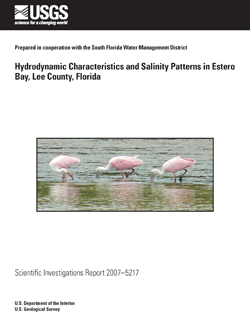Scientific Investigations Report 2007-5217
Prepared in cooperation with
South Florida Water Management District
 |
Select an option: |
|
CONTENTS Abstract Introduction Purpose and Scope Description of Study Area Previous Studies Approach Acknowledgments Methods of Investigation Monitoring Data Collection Salinity Surveys and Map Analysis Hydrodynamic and Salinity Characteristics in Estero Bay Discharge and Salinity at Passes and Tributaries Turbidity and Suspended Sediment Concentration Windspeed and Direction Salinity Patterns in Estero Bay Summary References Cited |
Estero Bay is an estuary (about 12 miles long and 3 miles wide) on the southwestern Florida coast, with several inlets connecting the bay to the Gulf of Mexico and numerous freshwater tributaries. Continuous stage and salinity data were recorded
at eight gaging stations in Estero Bay estuary from October 2001 to September 2005. Continuous water velocity data were recorded at six of these stations for the purpose of measuring discharge. In addition,
turbidity data were recorded at four stations, suspended sediment concentration were measured at three stations, and wind measurements were taken at one station. Salinity surveys, within and around Estero Bay, were conducted 15 times from July 2002 to January 2004.
The average daily discharge ranged from 35,000 to -34,000 ft3/s (cubic feet per second) at Big Carlos Pass, 10,800 to -11,200 ft3/s at Matanzas Pass, 2,200 to -2,900 ft3/s at Big Hickory Pass, 680 to -700 ft3/s at
Mullock Creek, 330 to -370 ft3/s at Estero River, and 190 to -180 ft3/s at Imperial River. Flood tide is expressed as negative discharge and ebb flow as positive discharge.
Reduced salinity at Matanzas Pass was negatively correlated (R2 = 0.48) to freshwater discharge from the Caloosahatchee River at Franklin Locks (S-79). Matanzas Pass is hydrologically linked to Hell Peckney Bay; therefore, water-quality problems associated
with the Caloosahatchee River also affect Hell Peckney Bay. Rocky Bay was significantly less saline than Coconut Point and Matanzas Pass was significantly less saline than Ostego Bay, based on data
from the salinity surveys. The quality-checked and edited continuous data and the salinity maps have been compiled and are stored on the U.S. Geological Survey South Florida Information Access
(SOFIA) website (http://sofia.usgs.gov).
Byrne, M.J., Gabaldon, J.N., 2008, Hydrodynamic Characteristics and Salinity Patterns in Estero Bay, Lee County, Florida: U.S. Geological Survey Scientific Investigations Report 2007-5217, 33 p.
U.S. Geological Survey
Florida Integrated Science Center
3110 SW 9th Avenue
Ft. Lauderdale, FL 33315
954-377-5900
| Accessibility FOIA Privacy Policies and Notices | U.S. Department of the Interior, U.S. Geological Survey
Persistent URL: https://pubs.usgs.gov/sir/2007/5217 Page Contact Information: USGS Publishing Network Page Last Modified: Thursday, 01-Dec-2016 20:02:31 EST |
 |